 |
|
|
| (Information by Peter Kessler, and from External Link: History of the Byzantine Empire (Live Science), and Otto's Reign in Italy (Stories Preschool).) |
|
|
| 867 - 886 |
Basil I |
First successor to thePhrygian dynasty. |
| 883 - 884 |
The Eastern Roman empire is enjoying a resurgence of fortune in southern Italy. Under Nicephorus Phocas the Elder, the Roman forces slowly reconquer Calabria from 883, with attacks being concentrated on territory aroundBenevento. Following the deposing of Duke Radelchis in Benevento, his successor, Aione, responds by capturing Bari, although he loses it again within a year. The eastern portion of Sicily is also recaptured. 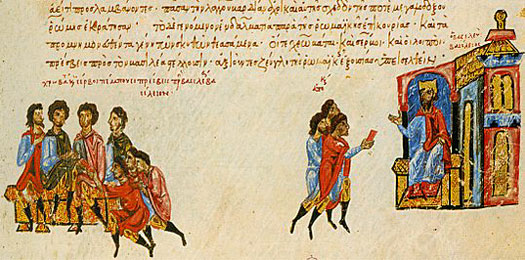 It would be another half a century or so after the Bulgars were beaten back by Knez Vlastimir of the Serbs that Serb and Croat delegations would be received by Eastern Roman Emperor Basil I It would be another half a century or so after the Bulgars were beaten back by Knez Vlastimir of the Serbs that Serb and Croat delegations would be received by Eastern Roman Emperor Basil I |
|
| 886 - 912 |
Leo VI the Wise |
|
| 886 - 913 |
Alexander |
|
| 891 - 895 |
Duke Orso of Benevento is deposed after the principality is captured by Sybbaticius, theEastern Roman strategos of Calabria. Benevento is made the capital of the thema of Langobardia until the region is taken from Byzantine hands by Duke Guy IV of Spoleto. |
|
| c.900 |
The Alani and the Khazars join together to defeat an Eastern Roman-led coalition which is aimed against the Khazar king, Benjamin. |
|
| 911 - 912 |
Extant documents begin to speak of a Varangian-Rus presence in Eastern Roman (Byzantine) military service, starting in this period in which seven hundred Rus (Rhos) are recruited as naval troops in the unsuccessful imperial expedition against Arab-held Crete. For this service they are paid one kentenarion, equivalent to thirty-two kilograms, perhaps of gold. Curiously, however, there seems to be no apparent numismatic record in the lands surrounding a Byzantine-Rus conflict of 911 to show that Rus mercenaries are able to take home their rewards. This could be proof that the Eastern Romans are maintaining a mid-fifth century ban on silver and gold being exported from the empire into barbarian lands. 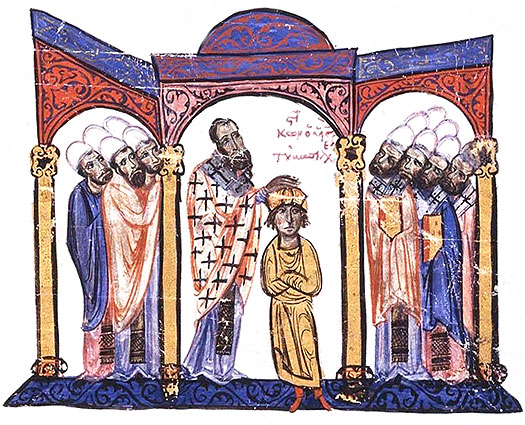 The shy, young Emperor Constantine VII of the Eastern Roman empire ruled with some reluctance, preferring the peace of his studies to the hurly-burly of court life The shy, young Emperor Constantine VII of the Eastern Roman empire ruled with some reluctance, preferring the peace of his studies to the hurly-burly of court life |
|
| 912 - 959 |
Constantine VII Porphyrogenitus |
Son. |
| 914 |
Shortly after Simeon of theFirst Bulgarian empire has happily accepted the title of 'tsar' from Patriarch Nicholas, Zoe, the powerful mother of the young Constantine VII, returns to the imperial court. The regents are removed, Zoe takes control of the throne, and the patrician is entirely sidelined from his office. Recognition of Simeon as 'tsar' is negated, even by removing it from some official documents. |
|
| 914 - 919 |
Zoe |
Mother and forceful regent. Deposed. |
|
The most important single source on Hungarian prehistory is the De Administrando Imperio of Emperor Constantine VII Porphyrogenitus. The tenth century work makes free and critical use of earlier sources and of information provided by Hungarians. It relates that the early Magyars, called at this stage Sabartoi asphaloi, live in the neighbourhood of the Khazars in a region called Levedia (named after their most senior chief). They are closely allied to the Khazars with whom they live together for three years, and whose king gives his daughter to their chief, Lebedias. It goes on to describe the Magyar exodus which delivers them to the Carpathian basin where they found their new state. |
|
| 915 |
As the latest in a series of conflicts with the Saracens, the forces of the new Eastern Roman strategos of Bari in Italy, one Nicolaus Picingli, assemble alongside those of various other southern Italian princes in the Christian League. It includes Landulf I of Benevento, John I and Docibilis II of Gaeta, Gregory IV and John II of Naples,Pope John X, Guaimar II of Salerno, and Alberic I of Spoleto. The allied Eastern Roman-Lombard army fights and defeats the Fatamids at the Battle of Garigliano, a drawn-out combination of fights and a siege. The Saracens find themselves in a worsening situation and eventually attempt to flee, only to be captured and killed. It is a militarily significant victory in the fight against Islamic advances in Italy. |
|
| 916 |
The Eastern Romans retake Epirus. |
|
| 917 |
The promised war between Zoe's Constantinople and Emperor Simeon ofBulgaria now erupts. Leo Phokas 'the Elder' invades Bulgaria with naval support. They stop en route to rest, close to the River Acheloos, and also close to the port of Anchialos (today's Pomorie). This is where Simeon finds them, and slaughters their unprepared forces. The Eastern Romans are utterly routed, with the Bulgarians chasing them to the outskirts of Constantinople. Another victory sees some of the last remaining cohesive Roman military units destroyed. |
|
| 919 - 944 |
Romanus I Lecapenus |
Regent, power behind the throne, and co-emperor (920). |
| 919 - 924 |
With Zoe now removed from power and sent back to a monastery, her replacement is Romanus I Lecapenus, equally powerful and politically wily. He marries his daughter - once promised to Simeon ofBulgaria - to Constantine VII and creates himself co-emperor in 920. Now unable to seal peace through marriage with Constantinople, Simeon instead wages a long and bloody war against the Eastern Romans. Zaharije Pribisavljević inSerbia is persuaded by the imperial court to rebel in 924. He already has the support of many Bulgarians who have tired of the unceasing campaigning. An initial force of loyal Bulgarians is routed, but a larger force deposes Zaharije, while much of the leading nobility is beheaded. Simeon takes direct control of Serbia. |
|
| 924 |
Constantine (VIII) |
Son of Romanus, attempted usurpation. |
| 944 - 945 |
Stephen |
|
| 944 - 945 |
Constantine (?) |
|
| 952 |
By the time of De Administrando Imperio, which is completed in this year, the Eastern Roman authorities no longer listSardinia as an imperial province, suggesting that they already consider it to be lost to them. By now the transformation from imperial governor to independent petty ruler is probably well under way, and may already be complete, but nothing is known of this process until the early eleventh century, when it is already over. |
|
| 953 |
In conflict against the Eastern Roman empire in almost every year between 950 and his death, Emir Sayfud Dawla of Aleppo now wins a notable victory near Germanikeia in the Taurus Mountains (modern Kahramanmaraş in Turkey). The patrikios, Leo Maleinos, is killed, while General Bardas Phocas the Elder is badly wounded. |
|
| 958 |
The Eastern Romans under Leo Phocas, brother of future Emperor Nicephorus II Phocas, end a run of victories by Sayfud Dawla after he is ambushed and heavily defeated at Raban. Sayfud Dawla does not regain the initiative and in 962 his palace outside Aleppo is even sacked. |
|
| 959 - 963 |
Romanus II |
|
| 960 - 962 |
Rus mercenary units are involved in a successful Eastern Roman naval expedition against Crete between 960-961, during which the amir of Crete is captured along with his large treasury and the rest of the wealth that is found on the island (including silver and gold). It is likely that the Rus units are then transferred to the Roman expedition to Cilicia which resumes in early 962 as part of the campaign to reconquer Syria. That year, fifty-four forts belonging to the amir of Tarsus are captured along with Anazarbus. Later in the same year, the Romans capture and raid Sayfud Dawla's capital of Aleppo (apart from its citadel). Germanikeia is taken towards the year's end.  This lead bulla seal depicting the Bulgarian 'First Empire' Tsar Peter I was reportedly found together with a hoard of solidi of Romanus I, Constantine II, and Romanus II, with the seal perhaps being tied a leather bag which contained the coins, possibly to make a Bulgarian imperial payment This lead bulla seal depicting the Bulgarian 'First Empire' Tsar Peter I was reportedly found together with a hoard of solidi of Romanus I, Constantine II, and Romanus II, with the seal perhaps being tied a leather bag which contained the coins, possibly to make a Bulgarian imperial payment |
|
| 963 |
Regency of Theophano |
|
| 963 |
Theophano, widow of Romanus II, regent for her infant sons Basil II and Constantine VIII (IX). |
|
| 963 - 969 |
Nicephorus II Phocas |
m Theophano. Murdered by John I. |
| 964 - 966 |
Fresh from their sweeping victory on Crete in 961, the Eastern Romans launch an attack on Kalbid Sicily between 964-965. Rus mercenary units participate in the campaign which aims to capture at least part of Sicily but which is unsuccessful. They also seize more than twenty fortresses in Cilicia, including Adana, Anazarbus, al-Maṣîṣa, and Ṭarsus. In 966, amongst other cities, the Romans capture Hierapolis and, in 968, reach as far south as the fortress of Arqa, to the south of Tripoli (which is not captured). Tripoli and Damascus are forced to pay tribute. |
|
| 965 |
Cyprus is recovered from theIslamic empire, but the final Eastern Roman stronghold on Sicily falls to the Fatamids. By this time communications between Constantinople and Sardinia have already been severed, leaving that island isolated and pushing the empire out of the western Mediterranean. |
|
| 967 |
Emperor Otto I of the Holy Roman empire repairs relationships with the republic ofVenice, firstly through a marriage and then by granting a general series of commercial agreements, with the Venetian dodge's family particularly benefiting. These agreements further strengthen Venice's ties to the west, which greatly angers the soon-to-be Eastern Roman emperor, John I Tzimisces, as Venice controls all sea trade between Western Europe and the Roman Levant in the east. |
|
| 969 |
Antioch is recaptured from the Islamic empire, by Michael Bourtzes and Peter the Eunuch on behalf of Emperor Nikephoros II. The city becomes the seat of a doux who commands the forces of the local themes which are vital for holding onto this eastern border region. Aleppo is reduced to vassal status. 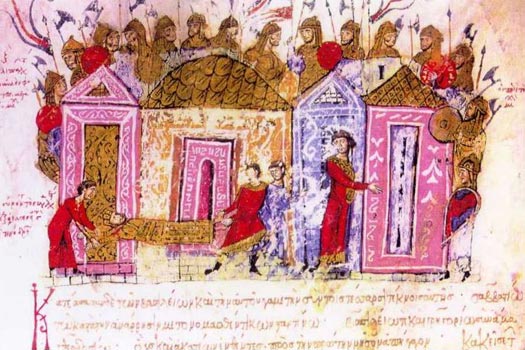 The Varangian Guards of the Eastern Roman court in the tenth century were recruited from eastern-travelling Vikings who came to Greece through the lands of the Rus The Varangian Guards of the Eastern Roman court in the tenth century were recruited from eastern-travelling Vikings who came to Greece through the lands of the Rus |
|
| 969 - 976 |
John I Zimiskes / Tzimisces |
Held power. |
| 963 - 976 |
Basil II Bulgaroctonus |
|
| 970 - 971 |
Having just defeated the Bulgarians again (in 969), Grand Prince Sviatoslav of Kyiv finally breaks the long peace between the Rus and the Eastern Romans which had been encouraged and supported by his late mother. He launches an invasion of the lower Danube in 970 and engages the Roman armies there in major battles between then and 971. Unfortunately for him, the forces of Emperor John Tzimisces are stronger than his. |
|
| 972 - 977 |
A Sunni Turk named Alp Takin drives the Fatamids out of Damascus and holds it for five years, negotiating with the Eastern Romans to prevent them from sweeping in to take over. In 977, Fatamid Caliph al-Aziz manages to regain control and tame the dissident Sunnis. 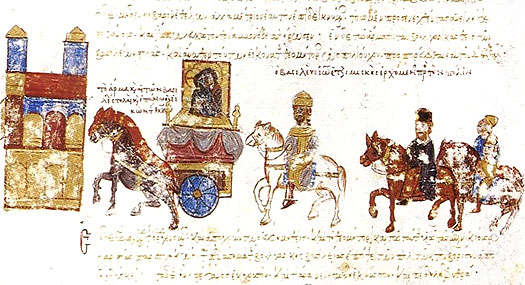 Eastern Roman Emperor John I Zimiskes returns in glory to Constantinople, with the captured Preslav Icon and Tsar Boris II of Bulgaria (second from right) Eastern Roman Emperor John I Zimiskes returns in glory to Constantinople, with the captured Preslav Icon and Tsar Boris II of Bulgaria (second from right) |
|
| 976 - 1028 |
Constantine VIII (IX) |
|
| 976 - 1025 |
Basil II Bulgaroctonus |
Remained co-emperor. |
| 976 |
The Eastern Romans are subjected to a major attack by theCometopuli, with the Macedonian town of Serres being besieged. North-eastern Bulgaria is recaptured by the cometopuli, in a notable territorial gain for the sons of the counts. Basil II is also fighting a rebellion in the east which is led by a general called Bardas Skleros. So he resorts to subterfuge with his Bulgarian adversaries by negotiating with one of their leaders alone. When the other discovers the deceit, the first is executed along with most of his family. |
|
| 976 - 979 |
Bardas Skleros |
Rebelled in Asia Minor. Exiled with Abbassids. |
| 988 |
Bulgaria takes the region of Epirus from the empire, along with Thrace and, soon after, theSerb province of Duklja. Simultaneously, Basil is rocked by the news that exiled rebel Bardas Phokas 'the Younger' has rebelled again, with initial support from the equally disgraced Bardas Skleros. Much of Asia Minor falls to him, and his forces are approaching the Dardanelles. 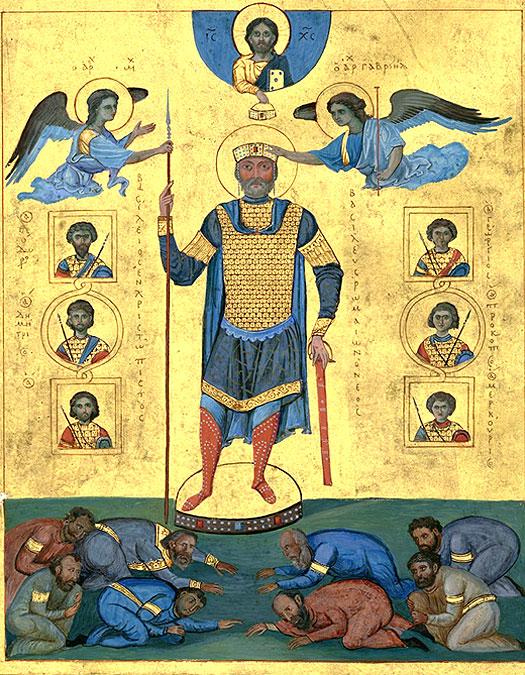 In Eastern Roman Emperor Basil II the Bulgarians found themselves an implaccable, unrelenting enemy who would not give up until their state had been destroyed In Eastern Roman Emperor Basil II the Bulgarians found themselves an implaccable, unrelenting enemy who would not give up until their state had been destroyed |
|
| 988 - 989 |
Bardas Phokas 'the Younger' |
Rebelled in Asia Minor. Died in battle of natural causes. |
| 988 - 989 |
Fortuitously, around the same time in 988, Grand Prince Vladimir I of the Kievan Rus dispatches four or six thousand (sources vary) Varangians to Constantinople at the request of the emperor. This is the first resumption of the supply of Varangian-Rus troops since Grand Prince Sviatoslav's attack of 970-971. With this supply of men Basil is able to establish the Varangian Guard. In effect, the guard are the formalisation of the practice of using Varangians which goes back at least to 911. They instantly prove their worth by helping to defeat Bardas Phokas in 989, although the rebel leader himself is killed by a seizure just as he is attacking Basil's front line in battle. |
|
| 992 |
Basil II agrees the first important commercial treaty with Venice, which give their merchants an advantage. |
|
| 1000 |
Basil annexes the Armenian principality of Taik following several pleas by David of Taik for protection against marauding Seljuq tribesmen. The move offers the principality direct Eastern Roman protection. 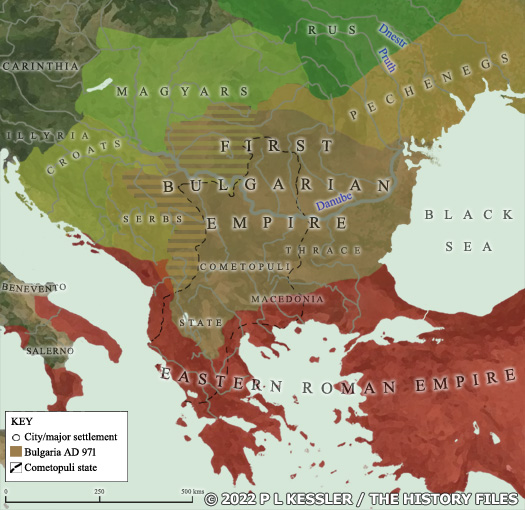 The (First) Bulgarian empire had controlled a great swathe of the Balkans during its existence, but its termination in 971 resulted in only its western territories remaining independent (within the dashed line), governed by the cometopuli (click or tap on map to view full sized) The (First) Bulgarian empire had controlled a great swathe of the Balkans during its existence, but its termination in 971 resulted in only its western territories remaining independent (within the dashed line), governed by the cometopuli (click or tap on map to view full sized) |
|
| 1014 |
Worn down by incessant Eastern Roman raiding every year, Tsar Samuel builds a long wooden defensive wall across their favoured line of advance through the Strumitsa river valley. At first the defence proves to be highly successful, but the Romans eventually find a way around. The mainBulgarian army is surprised and defeated. Emperor Basil II gains the epithet 'Bulgar Slayer' when he captures and blinds most of the 15,000-strong army on 29 July. The defeat fatally weakens the Bulgar state, and Samuel too. He reputedly suffers a heart attack when he sees his mutilated army return home. |
|
| 1018 |
Tsar Ivan Vladislav is killed while attacking Eastern Romans during the Battle of Dyrrhachium in 1018 (now Durrës inAlbania). Exhausted by the war and lacking a suitable successor, his widow, Maria, and a good manyBulgarian regional governors surrender to Basil II who then annexes Bulgaria to the empire. |
|
| 1021 -1022 |
Two further Armenian principalities are absorbed into the empire. In 1021 the ruler of Vaspurakan cedes his lands to Basil because he is unable to withstand the Seljuq Turkmen incursions. In 1022 Sempad of Ani hands over his principality to the emperor on the condition that he is allowed to continue to rule until his death. He is subsequently defeated outright by the Eastern Romans in 1045. |
|
| 1028 - 1050 |
Zoë Porphyrogenita |
|
| 1028 - 1034 |
Romanus III Argyrus |
|
| 1034 - 1041 |
Michael IV the Paphlagonian |
|
| 1035 |
Sons of Tancred de Hauteville of the Cherbourg peninsula, the Hauteville brothers arrive in southern Italy from Normandy. They have been enticed there after receiving requests for help from fellow Norman, Rainulf Drengot, count of Aversa. Soon after becoming involved with them, Guaimar IV of Salerno is required to send troops to support anEastern Roman expedition under General Giorgio Maniace. Guaimar sends a cohort of Lombards and Normans, prominent amongst whom is William de Hauteville who, in Sicily, wins the epithet 'Iron Arm'. |
|
| 1041 - 1042 |
Michael V Calaphates |
|
| 1042 - 1050 |
Theodora Porphyrogenita |
Joint empress with Zoë. |
| 1042 |
Zoë marries and confers the diadem on: |
|
| 1042 - 1055 |
Constantine IX (X) Monomachus |
|
| 1050 - 1056 |
Theodora |
Sole empress from 1055 |
| 1054 |
The patriarch of Constantinople, Michael I Cærularius, refuses to acknowledge the primacy of the apostolic successor to Peter.Pope Leo IX sends a legatine mission under Cardinal Humbert to Constantinople to discuss the church in the troublesome south ofItaly, but Humbert promptly excommunicates the patriarch. In return the patriarch excommunicates Humbert. This point is officially recognised as the start of the schism between the Eastern (Orthodox) and Western (Catholic) Churches based at theEastern Roman capital of Constantinople and Rome respectively. |
|
| 1056 |
The reign of Empress Theodora gives way to theNon-Dynastic rule of Michael VI. |
|
 |
|
|

 It would be another half a century or so after the Bulgars were beaten back by Knez Vlastimir of the Serbs that Serb and Croat delegations would be received by Eastern Roman Emperor Basil I
It would be another half a century or so after the Bulgars were beaten back by Knez Vlastimir of the Serbs that Serb and Croat delegations would be received by Eastern Roman Emperor Basil I The shy, young Emperor Constantine VII of the Eastern Roman empire ruled with some reluctance, preferring the peace of his studies to the hurly-burly of court life
The shy, young Emperor Constantine VII of the Eastern Roman empire ruled with some reluctance, preferring the peace of his studies to the hurly-burly of court life This lead bulla seal depicting the Bulgarian 'First Empire' Tsar Peter I was reportedly found together with a hoard of solidi of Romanus I, Constantine II, and Romanus II, with the seal perhaps being tied a leather bag which contained the coins, possibly to make a Bulgarian imperial payment
This lead bulla seal depicting the Bulgarian 'First Empire' Tsar Peter I was reportedly found together with a hoard of solidi of Romanus I, Constantine II, and Romanus II, with the seal perhaps being tied a leather bag which contained the coins, possibly to make a Bulgarian imperial payment The Varangian Guards of the Eastern Roman court in the tenth century were recruited from eastern-travelling Vikings who came to Greece through the lands of the Rus
The Varangian Guards of the Eastern Roman court in the tenth century were recruited from eastern-travelling Vikings who came to Greece through the lands of the Rus Eastern Roman Emperor John I Zimiskes returns in glory to Constantinople, with the captured Preslav Icon and Tsar Boris II of Bulgaria (second from right)
Eastern Roman Emperor John I Zimiskes returns in glory to Constantinople, with the captured Preslav Icon and Tsar Boris II of Bulgaria (second from right) In Eastern Roman Emperor Basil II the Bulgarians found themselves an implaccable, unrelenting enemy who would not give up until their state had been destroyed
In Eastern Roman Emperor Basil II the Bulgarians found themselves an implaccable, unrelenting enemy who would not give up until their state had been destroyed The (First) Bulgarian empire had controlled a great swathe of the Balkans during its existence, but its termination in 971 resulted in only its western territories remaining independent (within the dashed line), governed by the cometopuli (click or tap on map to view full sized)
The (First) Bulgarian empire had controlled a great swathe of the Balkans during its existence, but its termination in 971 resulted in only its western territories remaining independent (within the dashed line), governed by the cometopuli (click or tap on map to view full sized)